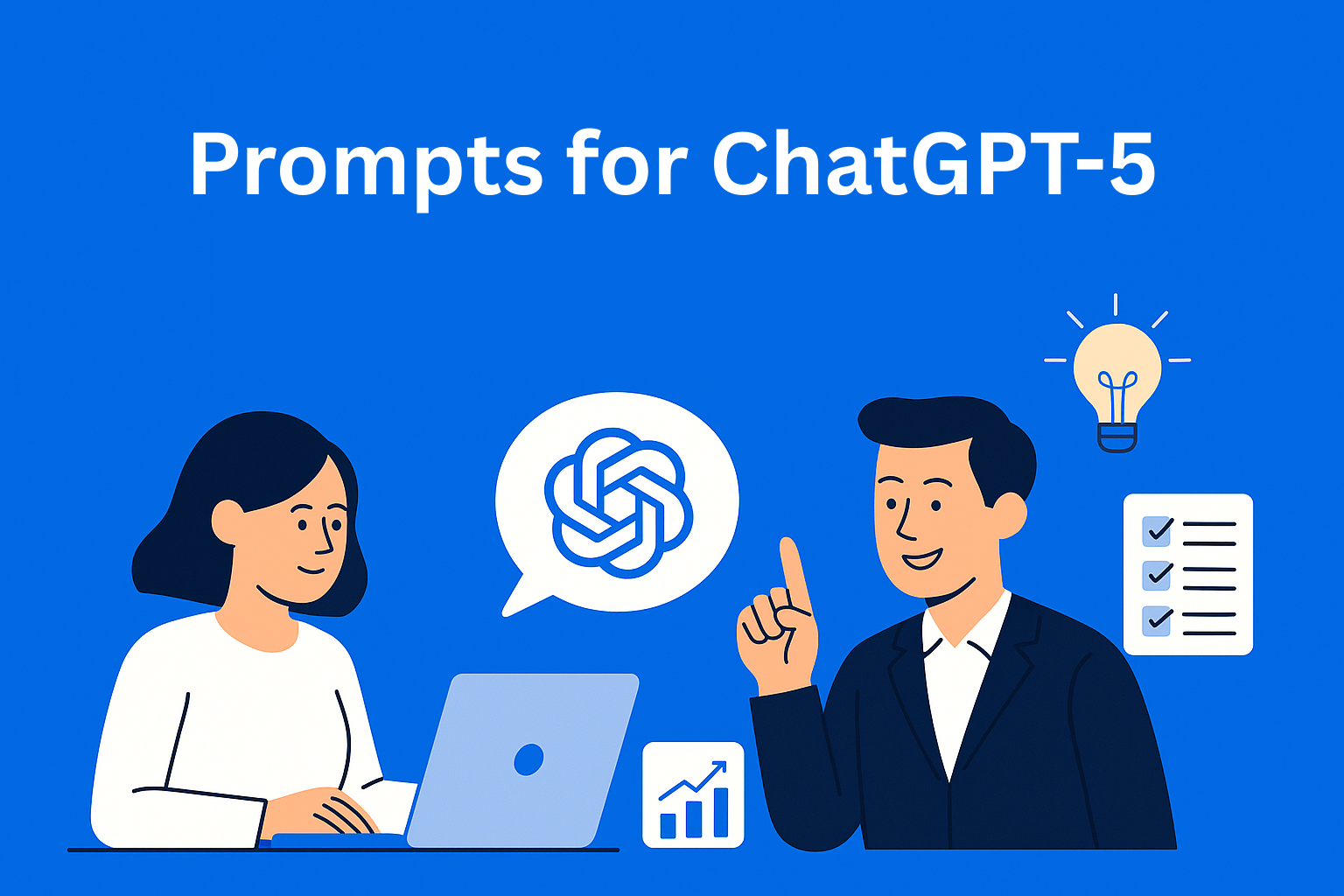Prompts for ChatGPT-5: How to Get Expert-Level Content Every Time
Learn how to craft powerful prompts for ChatGPT-5 and get expert-level content every time. Discover what’s new and see real prompt examples, explore simple techniques to boost creativity, SEO, and productivity with this next-generation AI tool.

If you use ChatGPT regularly, you already know it all depends on how you ask your question. Now, with ChatGPT-5, things go to the next level. This model is seriously powerful - it remembers better, understands deeper, and can create content that sounds like it was written by a professional. But even the smartest model won’t give you great results if it doesn’t know exactly what you want.
In this post, we’ll go over how to write great prompts for ChatGPT-5 so you can get exactly what you need, whether it’s a website article, a video script, or a business strategy.
Key Takeaways
- Great prompts unlock GPT-5’s full potential - even the smartest AI won’t deliver quality unless you’re clear about what you want.
- Structure matters: context, task, constraints - treat prompts like creative briefs to get precise and useful results.
- Role-based and layered prompting works best - assign roles, break big tasks into steps, and build outputs progressively.
- ChatGPT-5 thrives on nuance and refinement - use reflective prompts to revise and tailor results to your audience or tone.
- Prompting is now a core digital skill - knowing how to "talk" to AI effectively can massively boost productivity and content quality.
What’s New in ChatGPT-5?
Before jumping into examples, let’s quickly look at what makes GPT-5 special. It’s a big step up from GPT-4, especially in understanding context and handling longer conversations. It stays on track, picks up on tone better, and can tailor responses to your goal.
That means you can ask it slightly more complex but clearer questions. For example, you can ask it to explain a market like an expert would, or to write in a specific style (serious, casual, or professional). Sure, previous models could do this too, but this one does it even better.
What Makes a Good Prompt (and Why It Matters)
Even if you already know what a prompt is, it’s worth repeating for anyone new. A prompt is simply how you ask your question. A good prompt is like a well-briefed copywriter. It should have:
- Context - Briefly explain what you need and why.
- Task - Clearly state what you want ChatGPT-5 to do.
- Constraints - For example: word count, tone, format.
- Example (if needed) - If you know exactly what you want, give a sample.
For example: "Act as a senior UX designer. Write a list of best practices for onboarding screens in fintech apps. Keep it under 500 words and in a casual tone."
Prompts like this are clear and easy for ChatGPT-5 to understand. The more details you give, the better and more accurate the result will be.
Example Prompts for Expert-Level Content
You don’t have to be a prompt engineer to get great results. You just need to know what you want and phrase it well. Here are a few examples you can adapt:
- "Act as a senior marketing strategist. Write a 1000-word blog post about the future of email automation."
- "Summarize this legal document using plain English and highlight risks."
- "Create a content calendar for a B2B SaaS company for Q4."
- "Write a Python script that scrapes news headlines and summarizes them daily."
- "Draft a speech in the tone of Barack Obama for a tech conference keynote."
- "Generate a SWOT analysis for a mid-sized coffee chain in Europe."
- "Translate this article into Spanish, but localize idioms and references."
These prompts show you the kind of structure to aim for. They take advantage of ChatGPT-5 to create content that sounds natural and useful. Keep in mind, you’ll still want to edit the output - these prompts just make sure you have less work to do.
How to Get Even Better Results
Some tips if you want to take things further with ChatGPT-5:
- Role prompting - Ask the model to take on a specific role or expertise. For example: “Act as an SEO expert and explain how to optimize a website for Google.” This helps the model frame its answers from the right perspective.
- Chain-of-thought - Simply means asking the model to think step-by-step. For example: “Explain how inflation works, step-by-step, as if I’ve never heard of it before.” This way, you get a thorough explanation.
- Prompt layering - Break large tasks into smaller ones. First: “Make me an outline for a blog post on (topic).” Then: “Write the introduction for this outline.” Finally: “Add an SEO title and meta description.”
- Reflective prompting - Ask the model to improve its own previous answer. For example: “How would you make your last text more engaging for a LinkedIn audience?” or “Rewrite this to be clearer and shorter.”
These techniques work especially well with ChatGPT-5 because it’s smart enough to pick up on nuance and adapt to how you guide it.
Use ChatGPT-5 for SEO and Content Marketing
If you work in content marketing, you know how much time goes into writing, research, and optimization. ChatGPT-5 can be your right-hand assistant:
- Writes blog posts, headlines, and meta descriptions.
- Suggests SEO-friendly keywords.
- Creates outlines for articles, like the one you’re reading now.
A good SEO prompt might look like this:
"Act as an SEO expert. Generate 10 blog post titles for a fintech startup targeting millennial freelancers. Include high-search keywords."
Is It Worth Learning Prompt Engineering?
Absolutely. You don’t need a course - just learn to talk to it like a smart colleague instead of giving commands. ChatGPT-5 works best when you treat it as a partner helping you, not just a tool.
In short, prompting is becoming a new digital skill, kind of like knowing how to search Google well - only with far more possibilities.
Conclusion
With ChatGPT-5, you can easily create text that sounds like it was written by a team of professionals. But the most important thing is still how you ask the question. Spend a little time learning how to make clear and specific prompts, and you’ll get much better results while saving yourself time.






